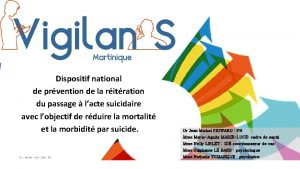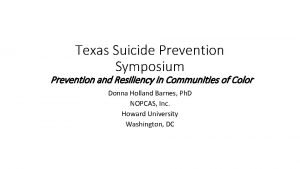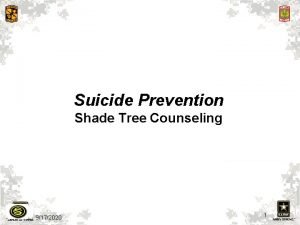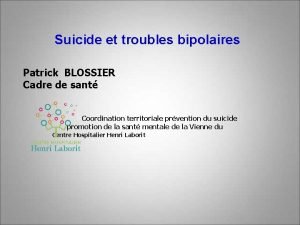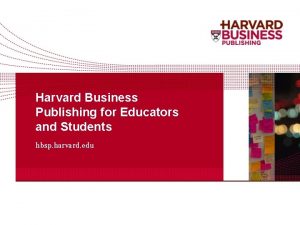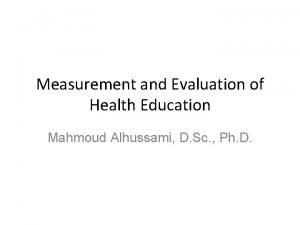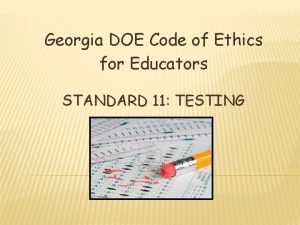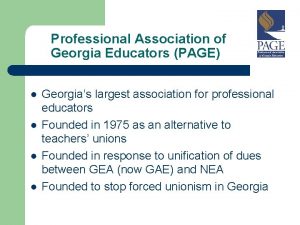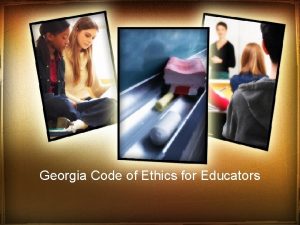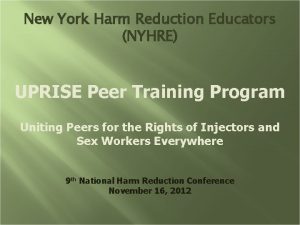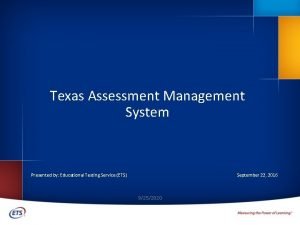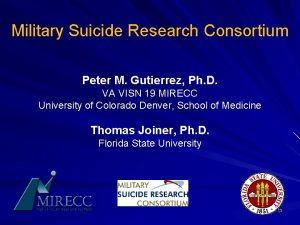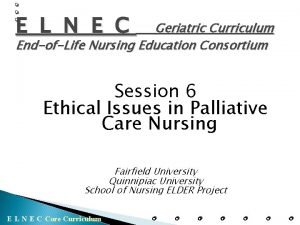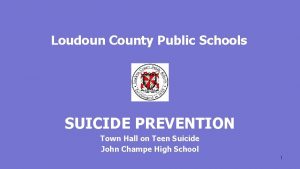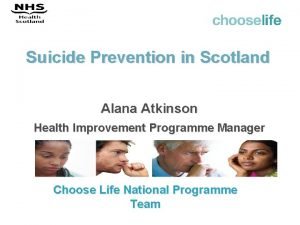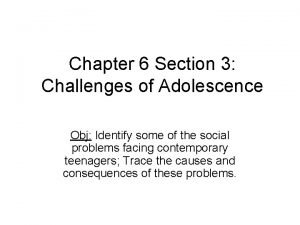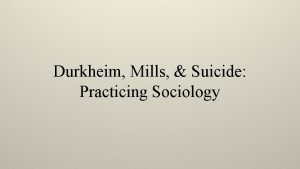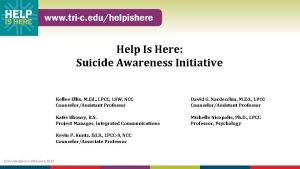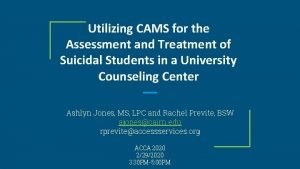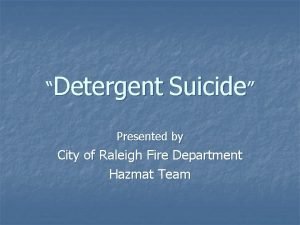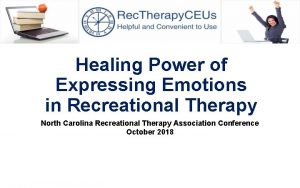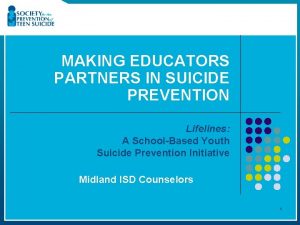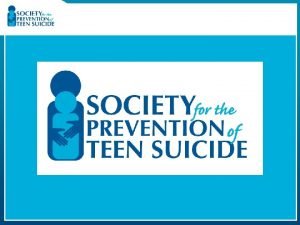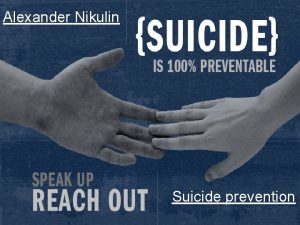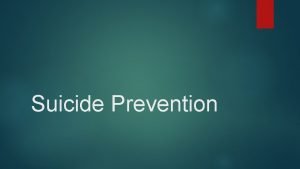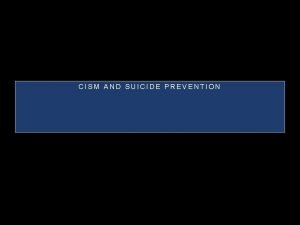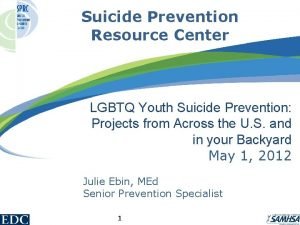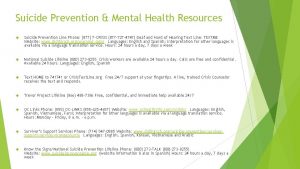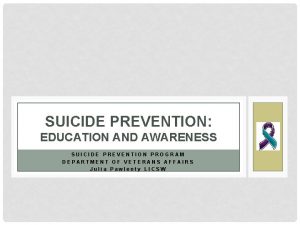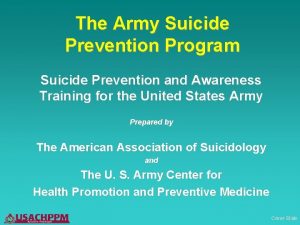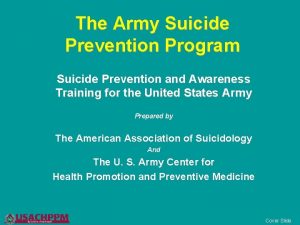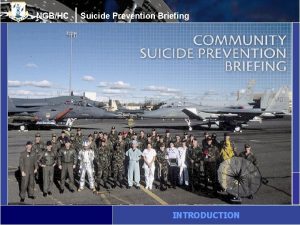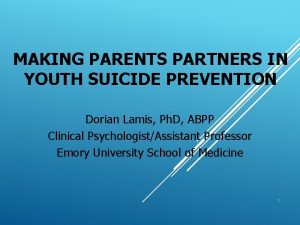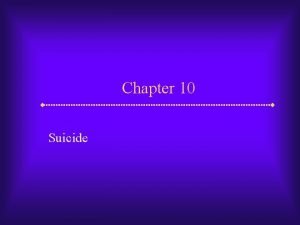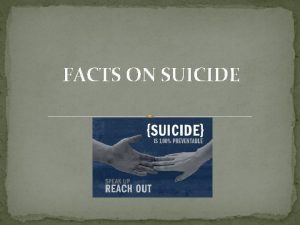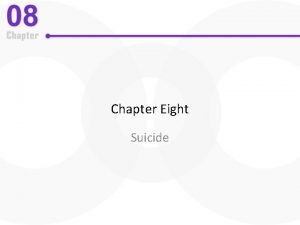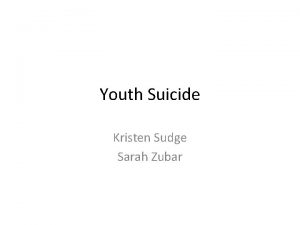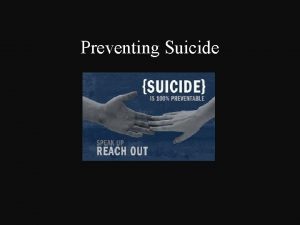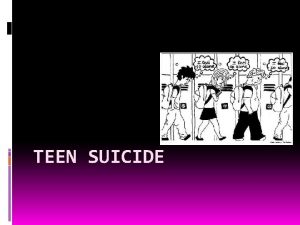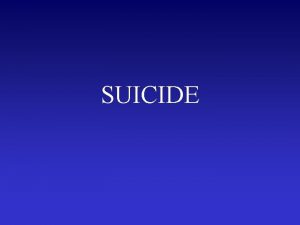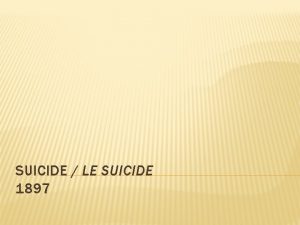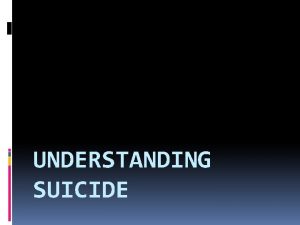MAKING EDUCATORS PARTNERS IN SUICIDE PREVENTION Lifelines A












































- Slides: 44

MAKING EDUCATORS PARTNERS IN SUICIDE PREVENTION Lifelines: A School-Based Youth Suicide Prevention Initiative Midland ISD Counselors 1

Educational Objectives l Review benefits l Correct myths l Present accurate data l Risk factors l Outline roles l Discuss interaction with students l Provide additional resources 2

Why Suicide Prevention is Important l Second leading cause of death for teens 15 -24 l Second leading cause of death in colleges l For every completion, there are between 50 -200 attempts l CDC Youth Risk Survey: 7. 8% grades 9 -12 reported attempt in past year l 15. 8% high school students report suicide ideation l Attempt rate increasing for 10 -14 year olds l Same risk and protective factors for suicide as other problem behaviors such as drugs, violence, risky sexual activities 3

Importance of teaching suicide- related content • 38, 364 people died by suicide in 2010 (105 a day) • Almost 80% of individuals who die by suicide saw a health care professional in the year prior to their death • Most health care professionals receive no training in suicide assessment and treatment 4

Youth suicide in Texas-2013 YRBS Felt sad or hopeless (almost every day for 2 or more weeks in a row so that they stopped doing some usual activities during the 12 months before the survey) 37% 28% 20% Total Female Male 5

Youth suicide in Texas-2013 YRBS Seriously considered attempting suicide (during the 12 months before the survey) 21% 17% 12% Total Female Male 6

Youth suicide in Texas-2013 YRBS Made a plan about how they would attempt suicide (during the 12 months before the survey) 16% 19% 12% Total Female Male 7

Youth suicide in Texas-2013 YRBS Attempted suicide (one or more times during the 12 months before the survey) 10% Total 12% 9% Female Male 8

Youth suicide in Dallas-2013 YRBS Attempted suicide that resulted in an injury, poisoning, or overdose that had to be treated by a doctor or nurse (during the 12 months before the survey) 3% Total 4% Female 3% Male 9

EVERY… l EVERY Year - there approximately 10. 45 youth suicides for every 100, 000 youth l EVERY Day - there approximately 12 youth suicides l EVERY 1 Hour and 54 Minutes - a person under the age of 25 completes suicide 10

Why Educator Training is Important: According to the Carnegie Task Force on Education: School systems are not responsible for meeting every need of their students, but when the need directly affects learning, the school must meet the challenge. 11

“Competent School Community” THE CONTEXT FOR PREVENTION l All members of the school community are concerned about the welfare of each other l They know how to obtain help for those who need it 12

Your Role Simplified l Learning signs of risk in students l Identifying at-risk students l Referring to appropriate resources 13

Role of Parents l Understand school’s policies and procedures l Recognize signs of trouble in their children l Know what to do and where to go for resources l Understand how to respond to other at-risk youth 14

Role of Students l Awareness of warning signs l Strategies for getting help personally l Knowledge of ways to help peers l Awareness of school and community resources l Identification of ‘caring’ adults 15

Your First Step Assessing Attitudes About Suicide 16

Questions to Consider: 1. I think suicide is a rational choice. sometimes ----------------------- Always Never 17

Questions to Consider: 2. I think suicide should be prevented no matter what. sometimes ----------------------- Always Never 18

Questions to Consider: I would do everything I could to prevent my teenager from dating someone who had attempted suicide. -----------------------I would respect my child’s choice. 19

Talking About Suicide On a 1 to 10 scale, rank how comfortable you are talking about suicide. -----------+-----------1 5 10 Very Uncomfortable Very Comfortable 20

Answering Common Questions Are School Programs That Address Suicide Safe? 21

Answering Common Questions Can Talking about Suicide Plant the Idea in the Minds of Vulnerable Teens? 22

Answering Common Questions Is Talking about Suicide Just a Way for Someone to Get Attention? 23

Answering Common Questions Do You Need to Address Suicide in Middle and Elementary School? 24

Suicide in Middle & Elementary School l l l Deaths by suicide infrequent under age 10 Attempts increasing dramatically in 10 -14 yr olds Risk factors may be seen in young children Impact of suicide on elementary school children primarily through suicide of parent, peer or other adult figure Protective factors can be encouraged in young children There ARE ways to respond that are more helpful than others 25

Answering Common Questions Where does developing competence in a school community begin? 26

Defining the Problem ATTEMPTED SUICIDE is a potentially self-injurious act Completed with at least some intent to die as a result of the act SUICIDE is an attempt to solve a problem of intense emotional pain with impaired problem-solving skills 27

Characteristics of Suicide 1. Alternative to problem perceived as unsolvable by any other means 2. Crisis thinking colors problem solving 3. Person is often ambivalent 4. Suicidal solution has an irrational component 5. Suicide is a form of communication 28

Risk Factors / Warning Signs Red - Warning Signs Yellow - Risk Factors Green - Protective Factors 29

Risk Factors for Youth Suicide Demographic Personality Factors Clinical Access to Means Family ‘Stressors’ 30

Risk Factors DEMOGRAPHIC l Age l Sex l Gender Identity l Race CLINICAL l Psychiatric diagnosis l Drug / alcohol use l Previous attempt 31

Risk Factors FAMILY l History of suicide EXPOSURE l To suicide (personally or in media) l Death of peer under any circumstance RECENT, SEVERE STRESSORS l Loss l Trouble l Change – transition 32

THE PERFECT STORM 33

Warning Signs F eelings A ctions C hanges T hreats S ituations 34

Students at Higher Risk l Threatening suicide l Looking for access to means l Talking or writing about death, dying, suicide l Previous attempt serious enough to require hospitalization 35

Talking with At-Risk Students l LISTEN u u l Acknowledge feelings in student’s terms Clarify Summarize Validate Know Your Limits u To ask about suicide directly? l Know Your Resources l Act l Follow-up 36

Risk Factors vs. Protective Factors 37

Protective Factors l Contact with a caring adult l Sense of connection or participation in school l Positive self-esteem and coping skills l Access to and care for mental / physical / substance disorders 38

Fostering Protective Factors l Teach students it is okay to ask for help l Give students permission to talk about traumatic events like suicide l Help students identify trusted adults l Encourage participation in school & community activities l Acknowledge student efforts l Be a good listener, as often as you can 39

Remember: Your Role Simplified l Learning signs of risk in students l Identifying at-risk students l Referring to appropriate resources 40

Web Resources l www. sptsusa. org Society for the Prevention of Teen Suicide Sponsor of this program, focuses on resources for the competent school community, including Lifelines, an evidence-based suicide prevention program for schools. Free on-line educator training! l www. suicidepreventionlifeline. org National Suicide Prevention Lifeline Free confidential, 24 -hour hotline, free materials l www. sprc. org Suicide Prevention Resource Center Resources for states, on-line library, best practices registry l www. suicidology. org American Association of Suicidology Data, resources, links, journal, national conference l www. thetrevorproject. org/ The Trevor Project Specific information for LGBTQ youth l www. afsp. org American Foundation for Suicide Prevention Survivor resources, research, and awareness 41

It’s in the Shelter of Each Other… 42

Revisit This Question: On a 1 to 10 scale, rank how comfortable you are talking about suicide, now? -----------+-----------1 5 10 Very Uncomfortable Very Comfortable 43

Questions? 44
 Primary prevention secondary prevention tertiary prevention
Primary prevention secondary prevention tertiary prevention Prévention du suicide
Prévention du suicide Texas suicide prevention symposium
Texas suicide prevention symposium Suicide prevention month quotes
Suicide prevention month quotes Mad acronym suicide prevention
Mad acronym suicide prevention Suicide prevention sink
Suicide prevention sink Army suicide prevention training
Army suicide prevention training Glencoe health chapter 5 vocabulary
Glencoe health chapter 5 vocabulary Shadetree army
Shadetree army Prévention suicide
Prévention suicide Suicide prevention chain teach
Suicide prevention chain teach Harvard business publishing for educators
Harvard business publishing for educators Measurement and evaluation for health educators
Measurement and evaluation for health educators Missouri educators trust
Missouri educators trust Lean innovation educators summit
Lean innovation educators summit Georgia educator code of ethics
Georgia educator code of ethics Professional association of georgia educators
Professional association of georgia educators Georgia code of ethics for educators
Georgia code of ethics for educators Earth educators rendezvous
Earth educators rendezvous New york harm reduction educators
New york harm reduction educators Allied educator moe
Allied educator moe Texas assessment managment system
Texas assessment managment system War making and state making as organized crime summary
War making and state making as organized crime summary What is inferring
What is inferring Digestive enzymes and their functions table
Digestive enzymes and their functions table Youth suicide research consortium
Youth suicide research consortium Cremation form geeky medics
Cremation form geeky medics Thomas joiner suicide
Thomas joiner suicide Ethical issues in nursing education
Ethical issues in nursing education 1941-1882
1941-1882 Mathieu sohier
Mathieu sohier Loudoun county student suicide
Loudoun county student suicide Scotland suicide statistics
Scotland suicide statistics Risicofactoren suicide
Risicofactoren suicide Suscinio suicide
Suscinio suicide Murder suicide moorpark
Murder suicide moorpark Dr. spock's son committed suicide
Dr. spock's son committed suicide Philipp budeikin
Philipp budeikin Rvguev death
Rvguev death Suicide cuts across all social categories
Suicide cuts across all social categories Types of suicide
Types of suicide 988 suicide
988 suicide Cams suicide assessment
Cams suicide assessment Detergent suicide
Detergent suicide Break up suicide
Break up suicide

